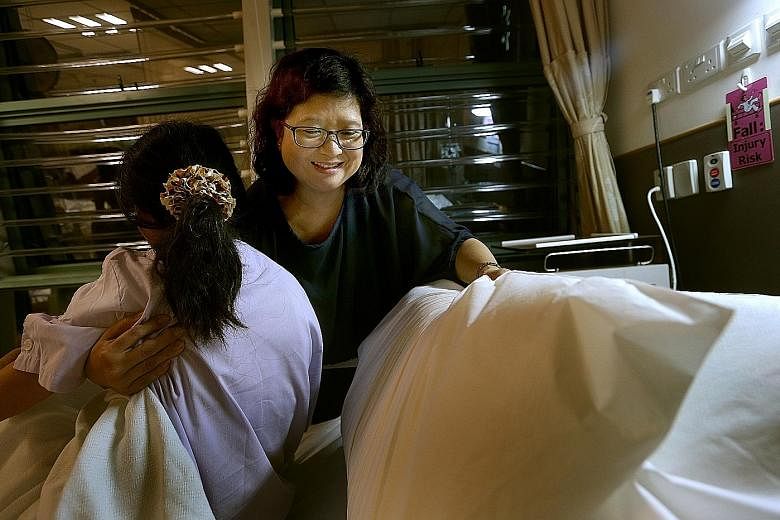She does not don a uniform, nor does she have any formal training in nursing, but Madam Lim Ai Siew turns up at Tan Tock Seng Hospital (TTSH) every Saturday at 4am.
From then until sunrise, the 57-year-old "night-sitter" keeps a watchful eye on patients, assisting with any basic requests, alerting nurses if they need care or just sitting by a bed and chatting with a wakeful patient till he or she falls asleep. She does this even though she is not on the hospital payroll.
Volunteers like her are a growing presence in public hospitals, becoming an informal workforce as their numbers rise and roles have diversified in recent years.
At TTSH, the number of volunteers has surged eightfold, from 100 in 2010 to 800 last year.
A similar uptrend has occurred at the Institute of Mental Health, whose volunteer numbers swelled from 150 to 400 in the same period.
And at Khoo Teck Puat Hospital, they more than quadrupled to 150 last year, from 35 in 2011, while the Yishun Community Hospital (YCH) next door has 120 volunteers on its list though it officially opened its doors only in November last year.
The Health Ministry acknowledges the rising significance of volunteers, such as in contributing to patient welfare.
"Volunteers play an increasingly important as well as diverse role in healthcare delivery," said a ministry spokesman. "They augment the workforce in healthcare institutions in certain care-related activities, but more importantly, bring care and concern to patients."
Volunteers fulfil a wide range of support roles in hospitals, from manning booths to helming patient support groups, and assisting with logistics and administrative work.
Some roles have also evolved to doing basic tasks in the wards, so they serve as helping hands to staff.
At Changi General Hospital, for example, volunteers help with "play therapy", engaging patients in activities like memory card games and mahjong under a nurse's supervision.
At National University Hospital (NUH), a programme called Silver Connection started in 2014 to promote social interaction among elderly inpatients, including those who are cognitively impaired. Volunteers carry out activities planned by nurses and therapists, reading a newspaper out loud or doing a Sudoku puzzle with the seniors.
Just this year, TTSH rolled out a sports integration scheme where volunteers assist therapists with sports used in rehabilitation, making sure that activities like seated volleyball and swimming are carried out smoothly.
"Volunteers can actually help to fill gaps," said Mrs Eunice Toh, director of development fund and volunteer management at TTSH, which is part of the National Healthcare Group.
"Those who go into the wards don't just sing songs - though we still have and appreciate such volunteers - but make an invaluable contribution in patient care," she said.
For one thing, they can indirectly free up nurses to attend to urgent tasks or those that require higher levels of care.
Night-sitters like Madam Lim, for example, accompany patients to the toilet if they can walk unassisted, or get a bedpan for them.
The full-time administrative executive, who said she saw an ad for volunteers in the newspaper years ago, also does "small acts" like soothe patients who are agitated and translate for those who speak in dialect.
These are tasks that an average layman can do - and it helps, noted Mrs Toh, adding: "Otherwise, a staff member will have to do them."
At YCH, volunteers help patients improve their functioning through activities like art therapy and horticulture. Said its volunteer coordinator Linda Ong: "This allows therapists to focus on rehabilitating patients."
More than 24,000 nurses and 1,400 therapists work in the public sector, according to official figures.
While hospitals do not set out to recruit volunteers, the hours they rack up could have a tangible pay-off.
Last year, volunteers at TTSH clocked more than 33,000 hours in total. "This is equivalent to hiring an executive for 13 years, or 13 executives in one year," said Mrs Toh.
Meanwhile, Singapore General Hospital (SGH) had more than 500 volunteers chipping in over 10,000 hours last year, said Ms Mumtaj Ibrahim, senior manager of SGH's community relations.
But even as more ordinary folk step up, there are limits to what - and how much - they can do.
Ms Noreza Sailani, a senior nurse manager at NUH, said: "There may be limitations as to what volunteers can do for patients as they are not qualified healthcare professionals."
A volunteer can check if a patient needs a drink, said Ms Noreza, but a nurse needs to supervise when the drink is offered depending on the patient's medical condition.
Physical aspects of care, like lifting a patient into a wheelchair, must also be left to the professionals.
Patient confidentiality is another minefield. What if volunteers innocuously offer advice on remedies, cite religious teachings or talk about a patient's health with another person? All these are not allowed, said hospitals.
Ms Mumtaj said volunteers are "strictly not allowed" to discuss patients' conditions or take their pictures, among other rules.
At NUH, all volunteers are briefed on matters such as privacy. Volunteers may have to sign a confidentiality agreement, as in TTSH's case.
Said Mrs Toh: "Generally, volunteers are not there to 'cure' a patient or to dispense advice, but to provide relief and a listening ear."


